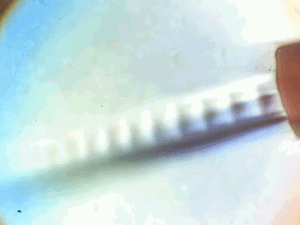How fast is the gas coming out from those little duster tubes of canned air? Perhaps faster than one might think! It’s supersonic (video, embedded below) as [Cylo’s Garage] shows by imaging clear shock diamonds in the flow from those thin little tubes.

Shock diamonds, normally seen in things like afterburning jet turbine or rocket engine exhaust streams, are the product of standing wave patterns that indicate supersonic speeds. These are more easily visible in jet plumes, but [Cylo’s Garage] managed to get some great images of the same phenomenon in more everyday things such as the flow of duster gas.
Imaging this is made possible thanks to what looks like a simple but effective Schlieren imaging setup, which is a method of visualizing normally imperceptible changes in a fluid’s refractive index. Since the refractive index of a gas can change in response to density, pressure, or temperature, it’s a perfect way to see what’s going on when there’s otherwise nothing for one’s eyeballs to latch onto.
Intrigued by this kind of imaging? It requires a careful setup, but nothing particularly complicated or hard to get a hold of. Here’s one such setup, here’s a Schlieren videography project, and here’s a particularly intriguing approach that leverages modern electronics like a smartphone.
Thanks to [Quinor] for the tip!















That was a canned demo in my compressible fluids course at college; the professor called it “shockwaves in a can.” Glad to see other folks coming across it; I thought that I was late to the party there.
Considering some of the crud trapped in people’s computers, “supersonic” is needed to break it loose. Followed up by a power-wash.
Aero engineer here- most aero undgrads have probably had tours of their department’s supersonic wind tunnel(s).. supersonic wind tunnels come in a few flavors, but a high pressure vessel with an outlet and valve is about all it takes to make up a supersonic wind tunnel.. A shock tube is a variant of this which can create a stationary shock wave in the throat of a nozzle or at the outlet of a tube.
Another type is a large vessel that is evacuated with a vacuum pump and connected to a test section that draws air in from the ambient atmosphere when the valve is opened, to achieve usually a few seconds of test time (vacuum supersonic tunnel). Pressure tanks and vacuum vessels can be combined to make a blowdown tunnel, and many of these can reach hypersonic speeds.
Most of these use Schlieren imaging to visualize and photograph the shock waves. Mach number can be measured from the angle of the oblique shock wave alone from M=1/sin(mach_angle). Welcome to the world of supersonic airfoils (which are diamond shaped), Busemann biplanes, mach diamonds, oblique shock waves, shock reflections, and subsonic flow regions.
In air, the gas inside a can is not of the same composition!
Speed of sound in difluoroethane is about 1/2 the speed of sound in air. The temperature of the gas in the tube is low and this puts the speed at the low end for the gas.
What does composition have to do w/mach diamonds?
I will never look at a Mach Diamond the same way again. 😀 now I will see this equation everytime I look at a Mach Diamond. M=1/sin(mach_angle)
I don’t think the fact that we see these waves, necessarily means that the same results from jets etc. scale down to this observation. Super sonic, probably not.
I think it is very hard to explain those diamond shapes any other way than by supersonic flow. Also, if you read some other replies, when pressurized gas is let freely out of a hole, it will generally rush out, reaching a limit only when it goes supersonic at the narrowest point in its path.
It’s well known that mach diamonds are produced from high pressure gas- very easy to do with an air compressor, just look at the shadow.
This is not that surprising, the speed of sound is different in other gases!
About have the speed in air for this gas and temperature. Difluoroethane.
Awesome. Thank you. Might mention the counter-intuitive fact that the low pressure in the jet can be down to 5 psi. Even in a rocket exhaust.
Actually, this is not at all surprising. Most aero engineers have learned at some point that any container with a sufficient pressure ratio over ambient is going to have a supersonic choked flow at the smallest point in the path to the exit. This happens like way more often than you might think, like balloons could get to those numbers.
Oh? Would someone please get Schlieren imaging of a whoopie cushion?
LMFAO! Nice! I second that thought!
Such a nice and simple Schlieren setup here. That’s at least half of the story, IMO. Makes me want to build one.
You dont really need a fancy setup to visualize this.
Hold a smartphone flashlight ~2 m away , and hold the compressed air can near a white wall.
Works even better with those cheap, but really bright LED flashlights that can focus to a narrow beam.